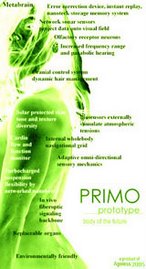As mentioned in the previous blogpost, there are various crossovers between technology and biology. This merger has given rise to ‘sciences of the artificial’, such as artificial intelligence (AI), and artificial life (Alife).
You might be familiar with the Steven Spielberg movie Artificial Intelligence: AI (2001), whereby a highly advanced robotic boy longs to become "real" so that he can regain the love of his human mother.
AI scientists predict that intelligent or ‘thinking’ machines can be created- and will be in the near future. However, humanists argue that machines are programmed to calculate solutions, and this does not qualify as thinking in the traditional sense. They argue there is no thinking in a machine, “only electrical charges exchanging input and output signals”[1]. AI scientists respond by pointing out that this is exactly how neuron activity in the brain also works; and don’t we consider this thinking?
There are two forms of AI: Classical AI, and Connectionist AI. Classical AI is concerned with the imitation of human intelligence in machines. The science claims to translate ‘the language of thought’ into computer programs. Connectionist AI on the other hand is concerned with the mere creation of intelligent machines, be it resemblance of human intelligence or not. Instead of replicating human intelligence, the science simulates the functions of human organs.
Alife replicates traditional biology by recreating biological phenomena. The science simulates biological systems relating to life through computer models, robotics, and biochemistry. Hence, there are three main kinds of Alife: soft from software, hard from hardware, and wet from biochemistry. According to Alife scientist John von Neumann, "life is a process which can be abstracted away from any particular medium"[2].
From the three abovementioned sciences of artificial life it is clear that technology has had to veer towards the physical (and not away from it) in aiming to serve the human culture.
I believe that it is this fresh understanding of artificial life that will open up people to the possibilities presented by AI and Alife, instead of fearing them.
References:
[1] Lister, M (ed). 2003. New Media: A critical Introduction. Routledge.
[2] Wikipedia-Artificial Life
Tuesday, August 28, 2007
Monday, August 27, 2007
The thin line between biology and technology
 Garlinggauge
GarlinggaugeAlthough technology is by definition considered artificial and biology natural, technology has been intimately linked to the possibility of creating ‘living’ things. What is it then about technology that relates it to the creation of life?
Cyborgs, clones and prosthetic devices seem to suggest that the human body is no more than an advanced ‘natural’ machine. Therefore, in the same way that human beings evolved from primates, technology has also evolved into artificial intelligence. For this reason, the line that distinguishes technology from biology has disappeared; giving rise to what is referred to as biotechnology.
This is seen in the common use of prosthetic devices, such as contact lenses, hearing aids and prosthetic limbs. The use of prosthetic devices is not merely an extension of the human body with a technological device, but rather the creation of a new physiological entity altogether.
This new physiological entity constructed from the merger of a prosthetic device and a biological organ forms an information circuit of energy exchange, which allows it to function as a single unit. This fusion of technology and biology implies that to some degree humans have become cyborgs.
According to cyberneticist Kevin Warwick, technology has the potential to impact on the relationship between human evolution and our physical transformation process. For this reason, Warwick argues, “it is no longer of advantage to either remain ‘human’ or evovle”. This implies that biological organs run the risk of being replaced by technological devices that perform the same functions. Therefore, Lister et al write, “biological entities have become components for the technological reconstruction of the bodies”.
Personally, I accept the use of prosthetic devices as necessary in medical situations. However, when you consider movies that depict supersoldiers, such as 'Universal Soldier' (1992) and 'Terminator' (1984), one has to wonder how long will these features remain solely in the medical field, before the military adopts them (if it hasn't already). We have to remember that most of our current technology (i.e. the internet) were primarily designed for and used in the military.
As mentioned in an earlier blogpost, some of these ‘cyberpunk’ science fictional movies appear farfetched, yet actually point to current developments in science technology.
Reference:
Lister, M (ed). 2003. New Media: A critical Introduction. Routledge.
Subscribe to:
Posts (Atom)
